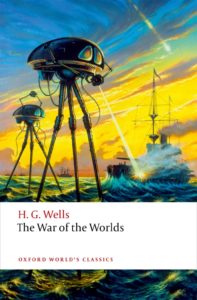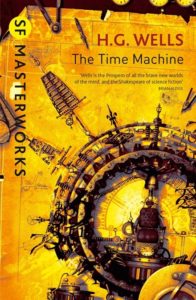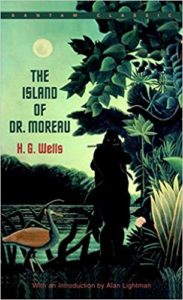For those who doubt that science fiction is rooted in the concepts of feminism, take at look at its primary parents: “Mama” Mary Shelley (Frankenstein) and “Papa” H.G. Wells. Mama, a noted feminist and radical thinker, started the genre with the publication of Frankenstein in January of 1818.
 Papa’s first was the serialization of War of the Worlds in The New Review in 1895. (It took a while for the guys to catch on). Wells rapidly surpassed Mama (in volume), with The Island of Dr. Moreau and The Time Machine published over the next two years and would go on to write over 13 novels and multiple non-fiction works, including two books on war games. His work encompassed the range of what we think of as science fiction today – time travel, futuristic societies, incredible technological weapons (in his case, nuclear weapons), and new means of communication (something that resembled the World Wide Web), among others.
Papa’s first was the serialization of War of the Worlds in The New Review in 1895. (It took a while for the guys to catch on). Wells rapidly surpassed Mama (in volume), with The Island of Dr. Moreau and The Time Machine published over the next two years and would go on to write over 13 novels and multiple non-fiction works, including two books on war games. His work encompassed the range of what we think of as science fiction today – time travel, futuristic societies, incredible technological weapons (in his case, nuclear weapons), and new means of communication (something that resembled the World Wide Web), among others.
Born in 1866, Herbert George was the son of middle-class parents with very different values – his mother, staunchly Protestant, and his father, an avowed free-thinker. Bedridden young due to a leg injury, Wells became a voracious reader. While the family’s money managed to hold out, he was privately educated; when fortunes changed, he was forced into an unhappy apprenticeship with a draper, then became an assistant to a chemist before receiving a life-changing scholarship to study with biologist T.H. Huxley. His first book was actually a textbook of biology (innovative title of Textbook of Biology) in 1893.
 With The Time Machine in 1895, he became an immediate success. The Island of Dr. Moreau returned the genre to Mama’s roots in science horror, as did The Invisible Man. Wells believed firmly in the “believability” of stories – that is, the science and concepts had to be credible enough to allow the reader to suspend disbelief.
With The Time Machine in 1895, he became an immediate success. The Island of Dr. Moreau returned the genre to Mama’s roots in science horror, as did The Invisible Man. Wells believed firmly in the “believability” of stories – that is, the science and concepts had to be credible enough to allow the reader to suspend disbelief.
Wells went on to write about utopias, such as his (again, spot-on title) A Modern Utopia. He embraced what was known as “the woman question” in favor of women and was an avid feminist, arguing vociferously for the radical concept of equal pay. However, his women characters followed the general arc of sexual liberation followed by an acceptance of domesticity and motherhood. (He couldn’t quite get to the concept of women desiring neither.)
“I want to see [women] citizens, with a marriage law framed primarily for them and their protection and the good of the race, and not for men’s satisfactions. I want to see them bearing and rearing good children in the State as a generously rewarded public duty and service, choosing their husbands freely and discerningly, and in no way enslaved or subordinated to the men they have chosen.” Wells, H.G. The New Machiavelli. London: John Lane The Bodley Head, 1911, 412.
 Wells, a dedicated free-love theorist, practiced precisely what he preached – free-love. Of course, the practicalities didn’t always precisely work out. Although he emphasized women’s rights and was known as a radical (socialism and modernism), he was called out by two ex-lovers for his lack of commitment to the cause, by both Dorothy Richardson and Dame Rebecca West. (For more on this, I recommend H.G. Wells’ Feminism and the Women who Deconstructed It.)
Wells, a dedicated free-love theorist, practiced precisely what he preached – free-love. Of course, the practicalities didn’t always precisely work out. Although he emphasized women’s rights and was known as a radical (socialism and modernism), he was called out by two ex-lovers for his lack of commitment to the cause, by both Dorothy Richardson and Dame Rebecca West. (For more on this, I recommend H.G. Wells’ Feminism and the Women who Deconstructed It.)
H.G. Wells would go on to inspire Robert Heinlein’s views of science fiction and society, with similar resulting sexy free-love women. Like Wells, Heinlein would, as his career progressed, also grow more concerned with societal implications.
Still, the man who would go on to be noted as the father of science fiction (along with Hugo Gernsback) tried. Bless his heart.
Featured image from War of the Worlds (2005) © Paramount Pictures, DreamWorks, and Amblin Entertainment

No Comments